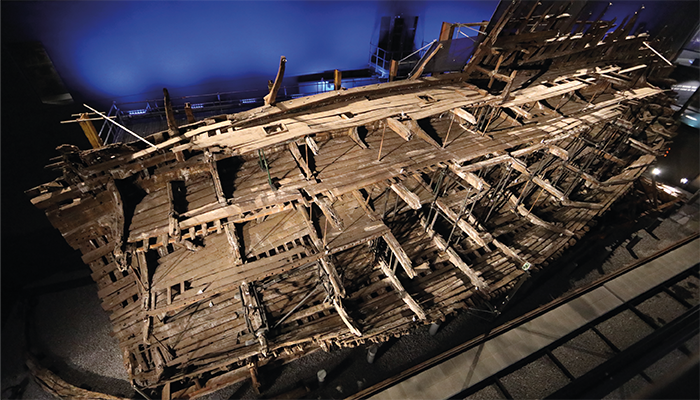
Credit: Geni, CC BY-SA 4.0, via Wikimedia Commons
Researchers examining the clavicle bones of 16th-century sailors from the Mary Rose, a Tudor warship, have discovered a possible connection between left/right-handedness of a person and their bone chemistry as they age.
The Mary Rose was the flagship of King Henry VIII but sank during the battle of the Solent in 1545. More recently, the remains of at least 179 crew members and over 19,000 objects were recovered in a four year excavation project. Thanks to the anaerobic environment formed by sedimentation, bone collagen and bone mineral concentrations in the skeletal remains of sailors on board the ship were surprisingly well preserved.
Enter a team from the University of Lancaster who were able to analyze – via Raman spectroscopy – 12 clavicle bones from sailors aged 13–40 to evaluate how repeated use affects bone chemistry.
The team compared chemical signatures of right and left clavicles, finding more pronounced age-related changes in the right clavicles compared with the left, which they attributed to the naturally higher proportion of people who are right-handed. A notable finding between the right and left clavicles was a distinct mineralization difference across all age groups. Higher mineral content, such as phosphate and carbonate, was observed on the right clavicle, corresponding with increased usage and remodeling associated with physical activity. Reduced protein content in older samples was also observed, but to a lesser degree.
Raman spectroscopy allowed the team to analyze the microstructure of bones without risking any physical damage to the archaeological samples. Additionally, the high sensitivity to mineral and protein markers in bone allowed them to map these subtle changes to an impressive degree of accuracy.
“The non-destructive nature of Raman spectroscopy makes it an ideal research tool for investigating human remains. We are delighted that the current research undertaken by Lancaster Medical School not only provides us with more information about the lives of our crew, but also demonstrates the versatility of Raman,” said co-author Alex Hildred in a press release. “The fact that this research has tangible benefits today, nearly 500 years after the ship sank, is both remarkable and humbling."
Looking forward, the team suggest that further tests using different spectroscopic techniques, coupled with imaging approaches, such as computed tomography osteoabsorptiometry (CTOAM) or nuclear magnetic resonance (NMR), should be conducted to attain more information from the samples.




